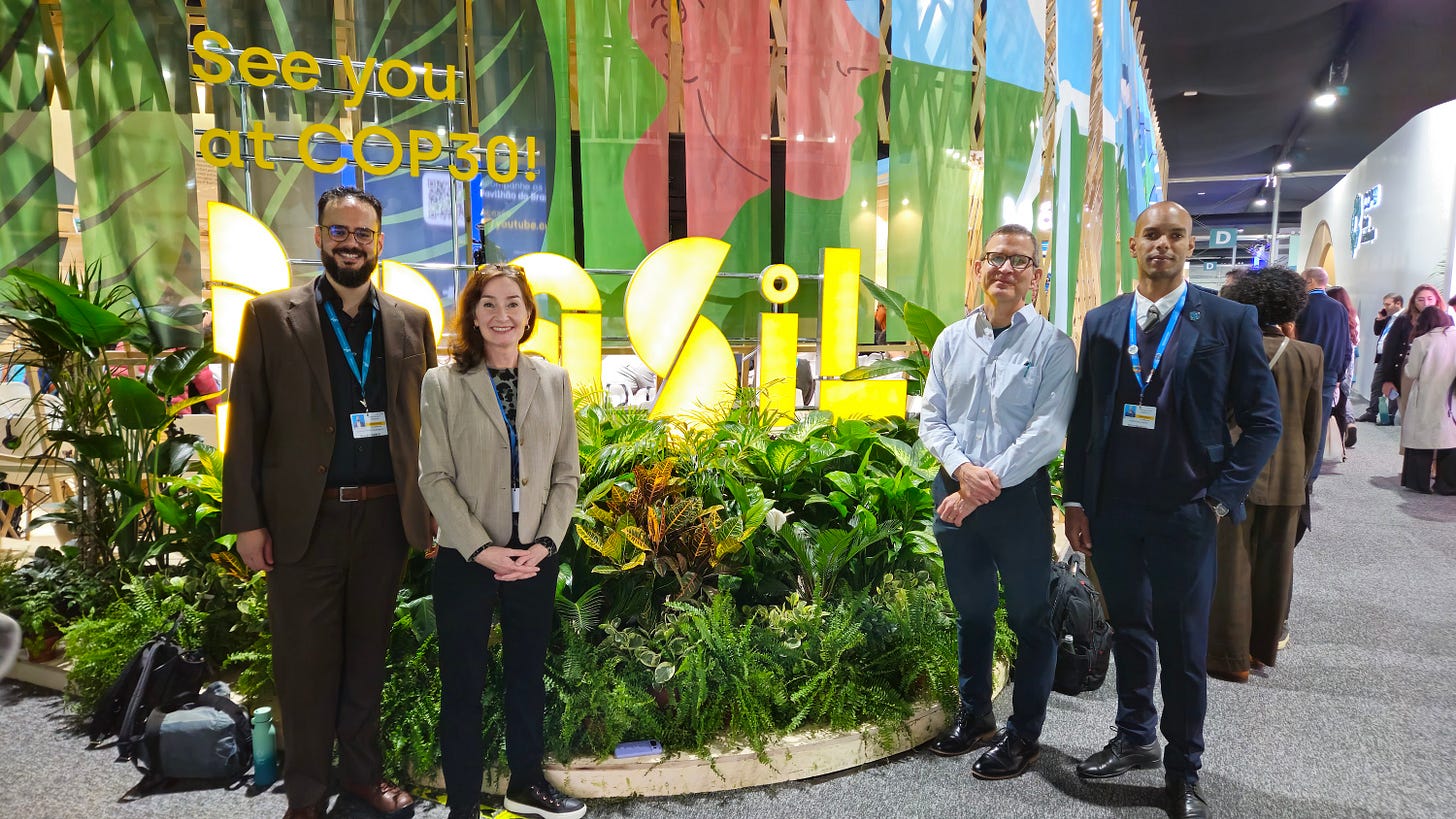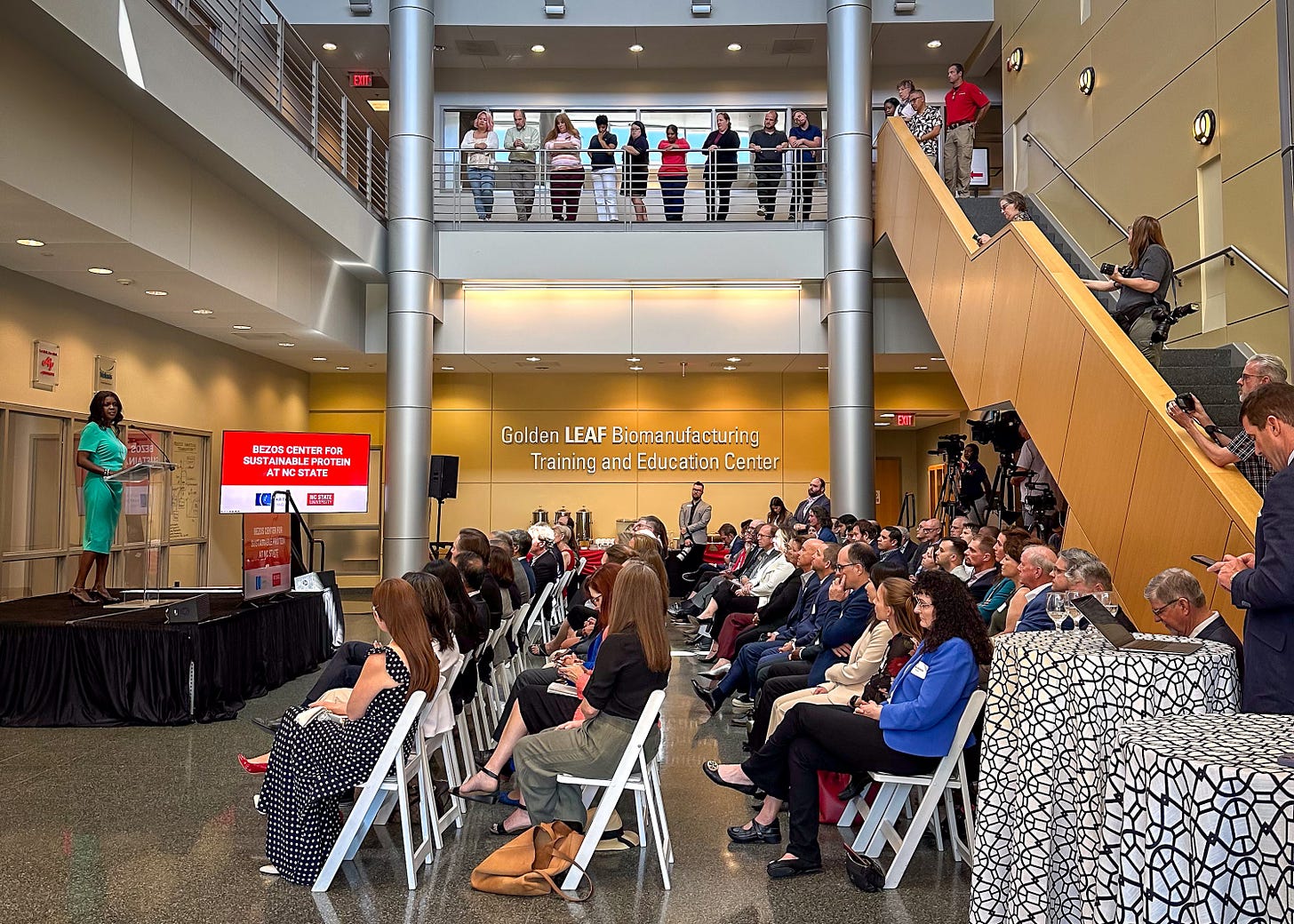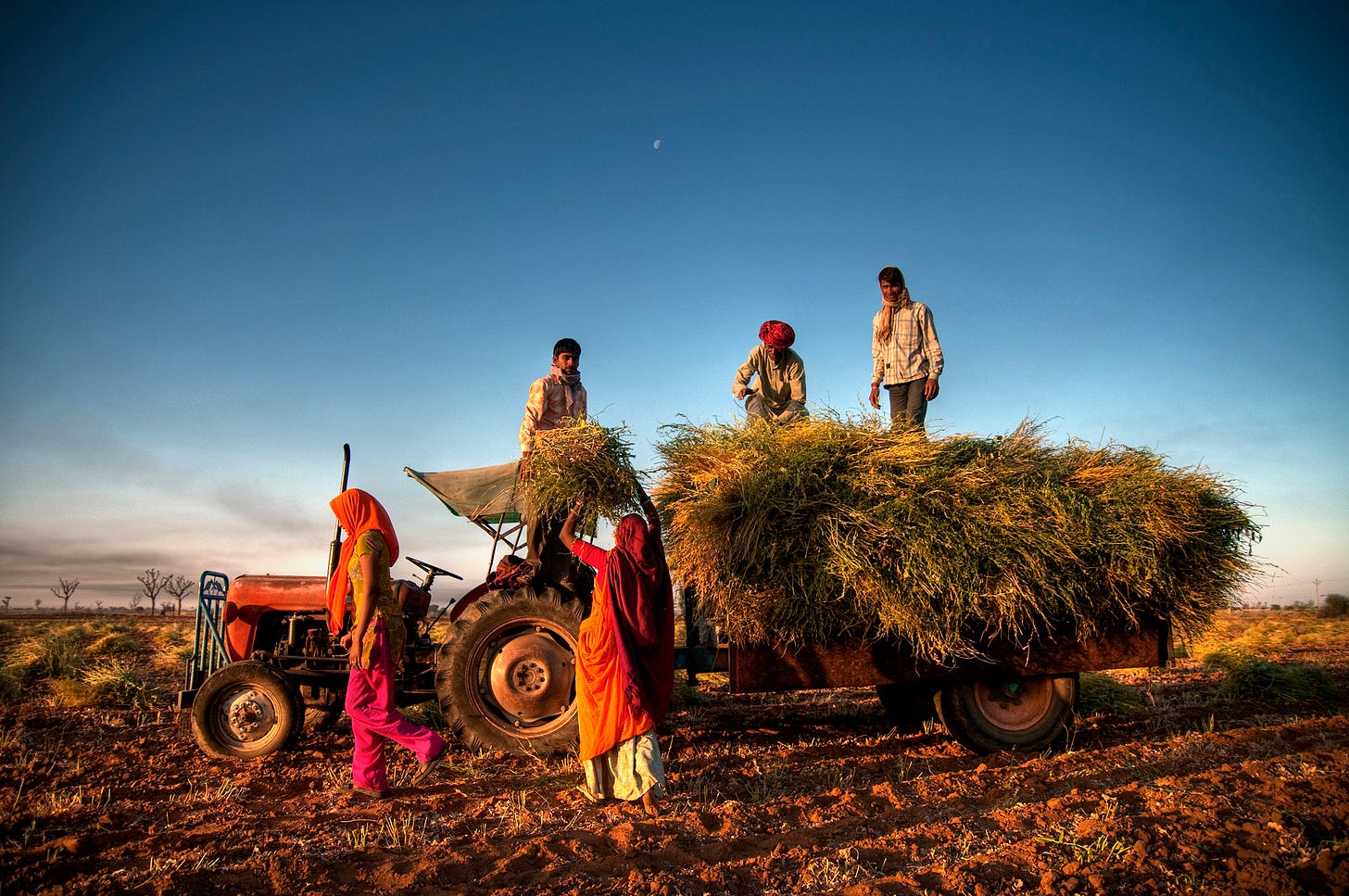How to build a thriving alt protein ecosystem in 2025
Global perspectives on what’s in store for alt proteins this year
Walking the path forward together
As we noted recently, the alternative protein sector celebrated many wins in 2024. There were milestones we saw coming–even some that were years in the making–as well as a few surprises along the way.
Naturally, you may be wondering what is in store for 2025. While we have some brilliant people working at GFI, none of us have a crystal ball–as much as we would like one. What we do have is a unique vantage point within the alternative protein ecosystem which allows us to connect dots and glean insights others may have overlooked
We’ve gathered some of those industry insights from 13 GFI experts from across Asia, Brazil, Europe, India, Israel, and the U.S. Here’s a small taste of what they think is in store for the alternative protein industry in 2025.
Curt Chaffin
Senior Fellow, Regional Bioeconomies, GFI (U.S.)
“Around the world, our leaders are embracing the power of biomanufacturing to create new jobs and opportunities for rural communities. There has been a groundswell of support for using our crops and biological resources to produce the things that we use and eat every day in more sustainable ways. The bioeconomy has the power to strengthen our national security, improve food system resilience, alleviate strains on soil and water health, and advance innovation for decades to come.
2025 should be a landmark year for food biomanufacturing and regional bioeconomy development. As GFI outlined in our recommendations to the Trump Administration, the emerging food biomanufacturing industry brings together three of America’s greatest strengths: farmers who are the backbone of our agricultural tradition, entrepreneurs who create economic promise, and scientific innovators who help build a better future for our entire country. We are eager to work with leaders around the country to advance food and the bioeconomy. From advancing executive-level support of biotech to state-wide advocacy to promoting scientific excellence, we will work to ensure that food and agriculture remain key priorities for decision-makers within the bioeconomy.”
Pauline Grimmer
Policy Manager, GFI Europe
“Europe’s fermentation companies felt the wind in their hair throughout 2024, and the coming year offers enormous potential for the region to become a world leader in this space. Germany’s Infinite Roots and ProteinDistillery, along with Finland’s Enifer saw growing investment to scale up biomass fermentation production, while new research centres such as the UK’s Microbial Food Hub, Ireland’s SUSFERM and Sweden’s Biotech Heights are now enabling academics to enter this field and collaborate with industry.
With almost half of the world’s fermentation manufacturing capacity situated in Europe, the region is ripe with opportunity. The new EU Commission has a real opportunity to use initiatives such as the Biotech Act to ensure Europe capitalises on its many strengths by providing the infrastructure our startups need to bring their innovations to market. Throughout 2025, we will make the case to policymakers, scientists, and business leaders that fermentation will play a central role in diversifying Europe’s protein supply, boosting food security, and providing a sustainable, healthy future for our citizens.”
Adam Leman, Ph.D.
Principal Scientist, Fermentation, GFI (U.S.)
“2025 is poised to be a big year for carbon capture technologies. How does that tie into alternative proteins? There are emerging biomass fermentation products where gaseous carbon like carbon dioxide and the potent greenhouse gas methane can be a feedstock for microbial growth. For these “gas fermentation microbes,” gasses would replace sugar as the primary carbon source that powers cell growth. In these cases, carbon that would end up in the atmosphere is removed and used in fermentation to build biomass molecules, like protein.
In parallel, another technology is scaling, which converts gaseous carbon to liquid feedstock that microbes can use to fuel their growth. Some liquid feedstocks are compatible with current infrastructure and biomass-producing microbes, so adopting these captured gas-to-liquid carbon feedstocks could be widespread. Using gas fermentation and feedstock conversion, the industry has a valuable and sustainable purpose for captured carbon – converting it into high-protein food ingredients. I look forward to more R&D and techno-economics publications in 2025 and plans for infrastructure that connects carbon capture to fermentation-derived alternative protein production.”
Kimiko Hong-Mitsui
Interim Director, GFI Japan
“Founded in late 2024, GFI Japan is laying a strong foundation to support future activities in the region. We look forward to leveraging our global network and resources to build a robust domestic organizational structure and foster relationships with local stakeholders. We are committed to forming impactful partnerships with Japanese academic institutions, government agencies, and industry associations to establish a dynamic science and technology ecosystem that accelerates innovation and market adoption of alternative proteins.
A key focus of our efforts is the development of a National Policy Plan designed to strengthen Japan’s R&D ecosystem, and enhance its competitiveness and leadership in alternative proteins on a global scale. We are also supporting the creation of a Cellular Agriculture Academic Society in Japan to advance academic collaboration, secure essential research funding, and promote interdisciplinary cooperation. Additionally, our initiatives prioritize active engagement with stakeholders across regions—from central Japan to rural areas—to foster trust, inclusivity, and progress toward shared goals.”
Daniel Gertner
Lead Economic and Industry Analyst, GFI (U.S.)
“Private investments in alternative proteins slowed in recent years amid elevated interest rates, uncertain scale-up timelines, and regulatory hurdles. In this evolving investment landscape, companies need to diversify their funding sources beyond venture capital alone. GFI’s Funding the Build report, published in 2024, explored potential avenues for companies looking to scale, such as equipment leasing, strategic partnerships, loans from multilateral financial institutions, blended finance, and government programs.
Still, there are no silver bullets to fill funding gaps in the sector, and additional solutions are needed. As companies learn to operate in this new environment, consolidation will likely occur. But consolidation should not be equated with decline. Mergers, acquisitions, and intellectual property transfers can accelerate the dissemination of technology and expertise—ultimately driving the sector forward. Plus, GFI’s recent plant-based meat pricing report and upcoming consumer segmentation research provide actionable insights for companies navigating this competitive landscape. Those that meet consumer needs by offering affordable, accessible, and tasty products will be best positioned to succeed in the next phase of industry development in 2025 and beyond.”
Gus Guadagnini
Chief Executive Officer, GFI Brazil
“As we approach COP30 in Brazil, 2025 offers an unparalleled opportunity to spotlight food systems as central to climate action. While COP29 secured an initial commitment of $300 billion annually for climate financing, scaling this ambition to meet the planet’s needs — especially those of the Global South — remains critical. Alternative proteins stand out as a proven and scalable solution, delivering emission reductions, strengthening food security, and creating economic opportunities. In Belém, we aim to advance this solution by showcasing how innovation in protein production can drive progress toward global climate goals. With strategic partnerships and actionable financing mechanisms, we have the tools to transform advocacy into measurable outcomes. The window to act is open, and the time to accelerate this shift is now.”
Madeline Cohen, J.D.
Associate Director, Regulatory Affairs, GFI (U.S.)
“In 2024, we saw cultivated meat come to market in Hong Kong, approved for sale in Israel, and pending authorization in a number of new jurisdictions, including Thailand, Korea, Switzerland, the United Kingdom, the European Union, and Australia/New Zealand. The new year is expected to bring cultivated meat to additional global markets, allowing more people to try delicious, real meat made in a new way.
Here in the United States, we look forward to working with incoming policymakers to capitalize on the many ways alternative proteins can bolster food security, diversify our food supply, and help lower prices at the grocery store. Public investment in alternative protein research and commercialization can accelerate our ability to rely on domestically grown foods and uplift American farmers. Alternative proteins are uniquely positioned at the intersection of agriculture and biotechnology, making them an ideal tool for both transforming the global bioeconomy and reinvigorating America’s agricultural leadership in 2025 and beyond.”
Ryan Huling
Senior Communications Manager, GFI Asia Pacific
“2025 will likely go in the history books as the year that cultivated meat went from being an exotic dish only available in business hubs like Singapore and Hong Kong, to an emerging technology explored by innovators across Asia Pacific. We are optimistic that this year will include the first-ever market approvals in South Korea and Australia/New Zealand (which share a regulatory body). It’s possible that Thailand could follow suit, and Malaysia is currently conducting a feasibility study of its domestic cultivated meat sector, commissioned by the prime minister. To further expedite such approvals, companies in the Asia-Pacific region, industry associations, think tanks, and government agencies are working together to harmonize regional regulatory frameworks so that startups can simultaneously roll out products in multiple markets.
Researchers in Singapore are also exploring new product formulations that can satisfy skyrocketing global protein demand without compromising on taste or price. The city-state’s Bezos Centre for Sustainable Protein is spearheading an effort to explore ‘hybrid’ proteins that bring together the best ingredients from plants, microbes, and cultivated animal cells. Similarly, Singapore’s Agency for Science, Technology, and Research (A*STAR) is collaborating with GFI APAC to conduct a consumer-focused sensory study of ‘blended’ meat products, which mix high-quality plant proteins into conventional meat in a way that reduces the overall percentage of animal-sourced ingredients in the final product. Several APAC-based startups are currently rolling out such products into what studies show could be a receptive regional market. If consumer uptake of blended products is strong enough, it could enable Asia’s plant-based meat producers to scale up their manufacturing capacity to service the increased demand. That can, in turn, create a virtuous cycle as greater economies of scale drive down plant-based meat prices across the board.”
Amy Huang
Senior Associate Director of Scientific Ecosystems, GFI (U.S.)
“Need some rational optimism? Look to academia! Let’s be real: 2024 was, on its face, a tough year for the alternative protein sector. But a look beneath the surface reveals a year of extraordinary progress that leaves the ecosystem brimming with optimism. And with good reason. In 2024, we saw a historic $400 million in public dollars awarded to the global research community, the launch of three Bezos Centers for Sustainable Protein (North Carolina State University, Imperial College, and the National Institute of Singapore), a wave of pioneering student leadership in new corners of the world, companies and higher education institutions working in concert to build vital training pathways for the alternative protein workforce, and other watershed moments yet to be announced 👀
Looking ahead, we’re feeling tremendously optimistic that 2025 will be a year to watch in terms of ushering in a more diverse talent ecosystem, with landmark conferences for scientific leaders, education and training programs, and other cross-sector collaborations on the horizon bringing important new stakeholders into the scientific ecosystem-building conversation. BIPOC, rural, and other under-invited and underrepresented communities around the globe have an indispensable role to play in architecting joyful, sustainable, resilient food futures, and this year, we’ll be encouraging deeper awareness and participation among these diverse communities and developing better resources and tools to meet their needs.”
Aviv Oren
Director of Innovation and Business Engagement, GFI Israel
“Innovation and venture creation in the alternative protein industry in 2025 is addressing critical challenges around taste, texture, price, and scalability with a focus on two main areas:
New ingredients from biomass fermentation and mycelium: Harnessing microorganisms like fungi and algae, biomass fermentation is transforming protein production. This scalable, cost-effective approach delivers high nutritional value and is being integrated into a wide range of applications, from meat alternatives to functional ingredients.
B2B deep-tech solutions for cultivated meat, fermentation, and plant-based protein production: Cutting-edge advancements in processing technologies, AI-driven optimization, plant-based crop improvement, and ingredient formulation are driving efficiency and scalability in cultivated meat, fermentation, and plant-based production. These innovations foster collaboration between food biomanufacturing and traditional food companies, accelerating sustainability and consumer-focused progress.
The trends in 2025 underscore the alternative protein sector's evolution, marked by improved taste, scalable solutions, affordability, and technological innovation, positioning it as a key driver of future food systems.”
Pat McAuley
Startup Innovation Lead, GFI (U.S.)
“In 2024 we saw a number of new product iterations focused on nutrition, especially in the plant-based meat category. Beyond Meat rolled out version 4.0 of its product line, featuring a condensed ingredient list, avocado oil, and a 75 percent reduction in saturated fat compared to conventional 80/20 beef, while Impossible Foods launched its Impossible Beef Lite. I anticipate innovation and reformulation will continue across alternative protein products in 2025 to better meet consumer demands around both taste and health.
In line with this trend, I expect a greater emphasis on consumer education and transparency. I think there will be a concerted effort across the industry to better educate consumers on how alternative proteins are made, the ingredients that go into them, and the health benefits of consuming them.”
Sneha Singh
Managing Director, GFI India
“I’ve witnessed the wonderful innovation, R&D, and manufacturing capacity of India firsthand. India is also quite a rich environment from an agricultural standpoint and there is so much scientific talent here. Last year, there was a huge spotlight on the International Year of Millets, and with that came signals that our government understands the importance of indigenous crops. With India’s strong manufacturing landscape, scientific talent pipeline, and agricultural heritage, we are in a strong position to make tremendous strides this year for smart proteins (as we like to call them in India).
This year, we are looking to answer a big question at GFI India: If the production of smart protein in India grows steadily, what does that growth story look like? There are a few projects I’m excited to work on this year that are designed to help us answer that. One huge opportunity for the sector is to produce a landscape analysis of alternative proteins in India to understand how India's existing manufacturing can plug into this nascent sector. Helping to develop a map of the ecosystem and opportunities for smart proteins would be valuable to all sorts of decision-makers, whether it's on the policy side, the industry side, or in the scientific landscape. We are also looking to do some work around nutrition. India has really high rates of malnutrition, stunting, and wasting. It is largely a protein-deficient country, and there is so much opportunity that we can tap into here to directly impact nutritional outcomes. So another question we hope to answer this year is around the steps we need to take to get smart proteins better integrated with government feeding programs, and to help demonstrate the benefit of the smart protein value chain to farmers in India.”
Abby Sewell
Corporate Engagement Manager, GFI (U.S.)
“In 2024, precision fermentation emerged as a standout process in the alternative protein industry, accounting for 32 percent of all investments in alternative proteins through by the third quarter. This technology is gaining traction among large companies as a strategic solution to mitigate supply chain risks and ensure consistent ingredient availability. Precision fermentation enables the production of ingredients like eggs, dairy, and even palm oil without reliance on conventional agricultural processes, offering scalable and environmentally sustainable alternatives. By reducing exposure to volatile agricultural markets and weather-dependent supply chains, companies can enhance resilience while meeting growing consumer demand for sustainable products.
Conventional dairy companies, such as Nestlé and Danone, are increasingly partnering with or investing in fermentation-focused startups to future-proof their portfolios. For example, collaborations between dairy giants and precision fermentation companies are helping accelerate the commercialization of animal-free dairy proteins. These innovations not only address supply chain challenges but also align with broader sustainability goals, making precision fermentation a cornerstone of the evolving food landscape.”









I want to help do research on this but there are so many options, I don't know where to start!
These insights makes me even more bullish on alt proteins this year! 👏🏾